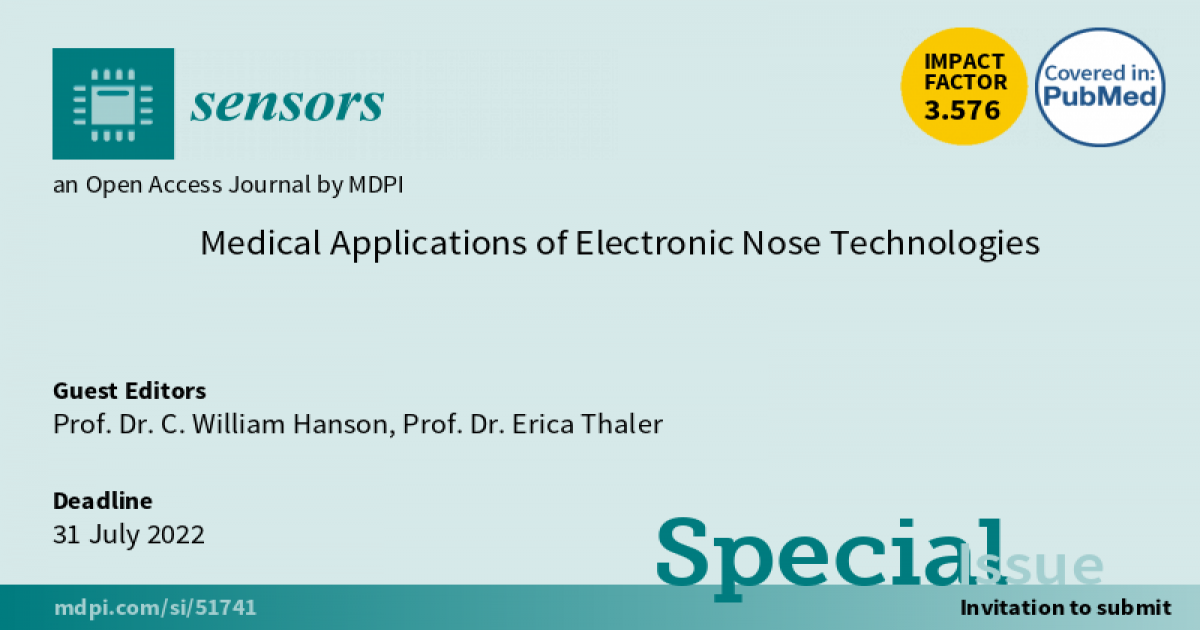- 3.5Impact Factor
- 8.2CiteScore
- 20 daysTime to First Decision
Medical Applications of Electronic Nose Technologies
This special issue belongs to the section “Chemical Sensors“.
Special Issue Information
Dear Colleagues,
Medical diagnostic techniques began with human senses and have evolved to include ever more sophisticated electronic wave form analysis, blood and bodily fluid testing, ultrasonic, and radiographic and genetic techniques (to name a few). The senses of taste and smell were among the earliest diagnostic tools, described by the earliest physicians, and yet they remain tantalizingly underused. This Special Issue of Sensors will be devoted to articles describing diagnostic applications of electronic taste and smell sensing in medical and veterinary care using chemical, gas, optical, electrical, biological/cellular, and other novel technologies. Submissions may focus on screening for disease, diagnosing disease or monitoring the course of/response to treatment of disease.
Prof. Dr. C. William Hanson
Prof. Dr. Erica Thaler
Guest Editors
Manuscript Submission Information
Manuscripts should be submitted online at www.mdpi.com by registering and logging in to this website. Once you are registered, click here to go to the submission form. Manuscripts can be submitted until the deadline. All submissions that pass pre-check are peer-reviewed. Accepted papers will be published continuously in the journal (as soon as accepted) and will be listed together on the special issue website. Research articles, review articles as well as short communications are invited. For planned papers, a title and short abstract (about 250 words) can be sent to the Editorial Office for assessment.
Submitted manuscripts should not have been published previously, nor be under consideration for publication elsewhere (except conference proceedings papers). All manuscripts are thoroughly refereed through a single-blind peer-review process. A guide for authors and other relevant information for submission of manuscripts is available on the Instructions for Authors page. Sensors is an international peer-reviewed open access semimonthly journal published by MDPI.
Please visit the Instructions for Authors page before submitting a manuscript. The Article Processing Charge (APC) for publication in this open access journal is 2600 CHF (Swiss Francs). Submitted papers should be well formatted and use good English. Authors may use MDPI's English editing service prior to publication or during author revisions.
Keywords
- Odor
- Taste
- Sampling
- Monitoring
- Electronic nose
- Electrical sensors
- Chemical sensors
- Gas sensors
- Optical sensors
- Biosensors
- Pattern recognition
- Electronic noses
- Electronic tongues
- Medical diagnostics

Benefits of Publishing in a Special Issue
- Ease of navigation: Grouping papers by topic helps scholars navigate broad scope journals more efficiently.
- Greater discoverability: Special Issues support the reach and impact of scientific research. Articles in Special Issues are more discoverable and cited more frequently.
- Expansion of research network: Special Issues facilitate connections among authors, fostering scientific collaborations.
- External promotion: Articles in Special Issues are often promoted through the journal's social media, increasing their visibility.
- e-Book format: Special Issues with more than 10 articles can be published as dedicated e-books, ensuring wide and rapid dissemination.

